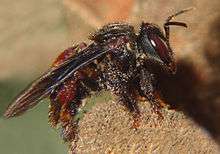Trigona
| Trigona | |
|---|---|
 | |
| Trigona spinipes | |
| Scientific classification | |
| Kingdom: | Animalia |
| Phylum: | Euarthropoda |
| Class: | Insecta |
| Order: | Hymenoptera |
| Family: | Apidae |
| Tribe: | Meliponini |
| Genus: | Trigona Jurine, 1807 |
| Subgenera | |
|
Duckeola | |
Trigona is the largest genus of stingless bees, formerly including many more subgenera than the present assemblage; many of these former subgenera have been elevated to generic status.[1] Trigona are oval-shaped creatures with golden-yellow and brown bands. Almost all Trigona bees have varying dark-to-light striations. Trigona are three to five millimeters in size, and have a slimmer body in total variance.[2]
Range
Trigona species occur throughout the Neotropical region, including South and Central America, the Mexican lowlands, and the Caribbean islands. They can occur in forests, savannas, and man made environments. Trigona bees are active all year round, although they are less active in cool environments.
Nesting
Trigona bees nests are constructed from wax they produce and plant resins they collect.[3] They usually nest in hollow trunks, tress branches, and underground.
Vulture bees
Vulture bees consist of three Trigona species that are the only known bees not to be herbivores. These bees collect and eat meat.
Communication
Some species of Trigona bees use saliva to lay scent trails guiding nest mates to a food source.[4] Some species of Trigona use eavesdropping which help them detect food sources being exploited by competitors.[5]
Role In Seed Dispersal
Eucalyptus seeds adhere to resin in the workers corbiculae and can be transported to the nest.[6] Workers transported seeds distance of more than three hundred meters; seeds at the nest were viable and capable of germination.
Selected species
- Trigona barrocoloralensis [7]
- Trigona branneri—Mato Grosso (BR) [8]
- Trigona carbonaria—Queensland (AU) [9][10]
- Trigona chanchamayoensis—Mato Grosso (BR) [8]
- Trigona cilipes—América
- Trigona collina—Thailand
- Trigona corbina—América (Mesoámerica-Costa Rica)
- Trigona corvina - Central and South America[11]
- Trigona iridipennis—India, Sri Lanka
- Trigona ferricauda—América
- Trigona fuscipennis [12]
- Trigona fulviventris—México.
- Trigona fuscipennis—México a Brasil.
- Trigona hockingsi—(AU) [13]
- Trigona hyalinata—Mato Grosso (BR) [8]
- Trigona minangkabau [7]
- Trigona nigerrima—América (México, Costa Rica).
- Trigona nigra—México.
- Trigona pallens—América
- Trigona recursa—Mato Grosso (BR) [8][12]
- Trigona siLvestriana—América (Costa Rica)
- Trigona spinipes-arapuá (BR) [14]
References
- ↑ Michener, C.D. (2000). The Bees of the World. Johns Hopkins University Press
- ↑ Mail, Rintos (2014-08-30). "Stingless bee honey – the Mother Medicine". BorneoPost Online | Borneo , Malaysia, Sarawak Daily News. Retrieved 2017-06-28.
- ↑ Wallace, H.M. (1995). "Dispersal of Eucalyptus torelliana seeds by the resin-collecting stingless bee, Trigona carbonaria". Oecologia.
- ↑ Schorkopf, Dirk Louis P.; Jarau, Stefan; Francke, Wittko; Twele, Robert; Zucchi, Ronaldo; Hrncir, Michael; Schmidt, Veronika M.; Ayasse, Manfred; Barth, Friedrich G. (2007-03-22). "Spitting out information: Trigona bees deposit saliva to signal resource locations". Proceedings of the Royal Society of London B: Biological Sciences. 274 (1611): 895–899. ISSN 0962-8452. PMC 2093984
 . PMID 17251108. doi:10.1098/rspb.2006.3766.
. PMID 17251108. doi:10.1098/rspb.2006.3766. - ↑ Nieh, James C.; Barreto, Lillian S.; Contrera, Felipe A. L.; Imperatriz–Fonseca, Vera L. (2004-08-07). "Olfactory eavesdropping by a competitively foraging stingless bee, Trigona spinipes". Proceedings of the Royal Society of London B: Biological Sciences. 271 (1548): 1633–1640. ISSN 0962-8452. PMC 1691773
 . PMID 15306311. doi:10.1098/rspb.2004.2717.
. PMID 15306311. doi:10.1098/rspb.2004.2717. - ↑ Wallace, H. M.; Trueman, S. J. (1995-09-01). "Dispersal of Eucalyptus torelliana seeds by the resin-collecting stingless bee, Trigona carbonaria". Oecologia. 104 (1): 12–16. ISSN 0029-8549. doi:10.1007/bf00365556.
- 1 2 Hoshiba and Imai (1993). "Chromosome evolution of bees and wasps (Hymenoptera, Apocrita) on the basis of C-banding patterns analyses". Japan Journal of Genetics.
- 1 2 3 4 Kleber França Costa; Rute Magalhães Brito; Carlos Suetoshi Miyazawa (2004). "Karyotypic description of four species of Trigona (Jurine, 1807) (Hymenoptera, Apidae, Meliponini) from the State of Mato Grosso, Brazil" (PDF). Genetics and Molecular Biology. Brazilian Society of Genetics. 27 (2): 187–190. doi:10.1590/s1415-47572004000200010.
- ↑ "The southernmost stingless bee in the world". Aussie Bee Bulletin (1). February 1, 1997.
- ↑ "Stingless Bees (Trigona and Austroplebeia)".
- ↑ Michener, Charles D. (1946-09-01). "Notes on the Habits of Some Panamanian Stingless Bees (Hymenoptera, Apidæ)". Journal of the New York Entomological Society. 54 (3): 179–197. JSTOR 25005167.
- 1 2 Tarelho, Z. V. S. (1973). Contribuição ao estudo citogenético dos Apoidea (masters thesis). University of São Paulo, Ribeirão Preto.
- ↑ "Bees in your area".
- ↑ Brito and Pompolo (1997). "C:G patterns and fluorochrome staining with DAPI and CMA3, in Trigona spinipes (Jurine, 1807) (Hymenoptera, Apidae, Meliponinae)". Brazilian Journal of Genetics.